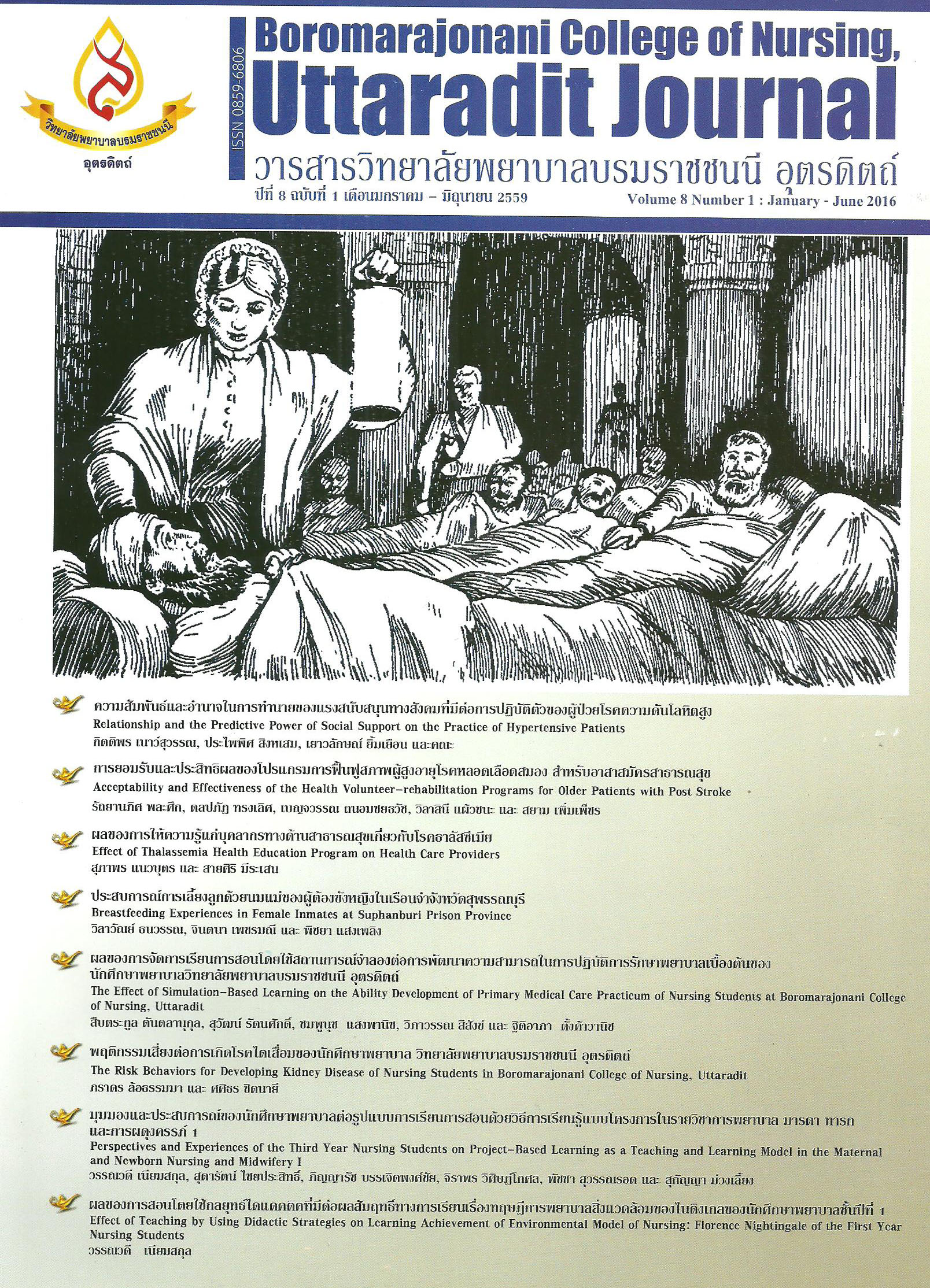ผลของการให้ความรู้แก่บุคลากรทางด้านสาธารณสุขเกี่ยวกับโรคธาลัสซีเมีย
Main Article Content
บทคัดย่อ
This one group pre-test and post-test study design to examine the effect of thalassemia health
education program on healthcare providers; to compare mean score of the knowledge, attitude and
practice to provide advice on thalassemia of health care providers between before and after program
and to examine the health care providers’ program satisfaction and self-evaluation. Subjects were 73
village health volunteers at Wang-ie-tog health promotion hospital, Phitsanulok province. The subject
participated in 2 times (for September, 2014 to January, 2015) of thalassemia health education program
with cartoon animation, cartoon books, brochures and posters. Research tool used to measure before and
after was questionnaire of knowledge, attitude and practice to provide advice on thalassemia. Data were
analyzed using descriptive statistics and inferential statistics.
The results found that mean score of the knowledge, attitude and practice to provide advice on
thalassemia was significantly increased after received health education program at p-value < 0.001,
(t = -13.27, t= -5.53 and t = -9.86). The result of program evaluation and self- evaluation of health
care providers were also found that after training, the subjects were very satisfactory as most all areas
including book, video-based training, media training, method to transfer knowledge, technique used to
convey knowledge, difficulty to convey knowledge and the ability to convey.The results of this study
indicated that nurses and health care providers should apply the thalassemia health education program
as a valuable complementary approach for controlling and screening thalassemia among the risk persons
and pregnancy women.
Article Details
บทความหรือข้อคิดเห็นใดใดที่ปรากฏในวารสารวิจัยการพยาบาลและวิทยาศาสตร์สุขภาพ เป็นวรรณกรรมของผู้เขียน ซึ่งบรรณาธิการหรือสมาคมศิษย์เก่า ไม่จำเป็นต้องเห็นด้วย และบทความที่ได้รับการตีพิมพ์เผยแพร่ถือเป็นลิขสิทธิ์ของวารสารวิจัยการพยาบาลและวิทยาศาสตร์สุขภาพ
References
2. นิภา มนูญปิจุ. (2528). การวิจัยทางสุขศึกษา. พิมพ์ครั้งที่ 2. กรุงเทพฯ: อักษรบัณฑิต.
3. ภัทระ แสนไชยสุริยา. (2555). การเผยแพร่ความรู้โรคธาลัสซีเมียผ่านสื่อ internet Web-based interactive media for disseminating knowledge of thalassemia. (รายงานวิจัย ม.ขอนแก่น),สืบค้นเมื่อ 26 พฤษภาคม 2558 จาก http://dric.nrct.go.th/direct_fulltext.php?.pdf.
4. วิเชียร เกตุสิงห์. (2538). สถิติวิเคราะห์สำหรับการวิจัย. พิมพ์ครั้งที่ 3. กรุงเทพมหานคร: ไทยวัฒนาพานิช.
5. สุวิมล ติรกานันท์. (2543). ระเบียบวิธีการวิจัยทางสังคมศาสตร์: แนวทางสู่การปฏิบัติ. พิมพ์ครั้งที่ 2. กรุงเทพฯ:โรงพิมพ์แห่งจุฬาลงกรณ์มหาวิทยาลัย.
6. Alam et al. (2015). How can formative research inform the design of an iron-folic acid supplementation intervention starting in first trimester of pregnancy in Bangladesh?. BMC Public Health, 15(374),1-9.
7. Bloom, B.S. et al. (1956). Taxonomy of educational objectives: The classification of educational goals. Handbook I: Cognitive domain. NY: David McKay.
8. Jopang Y. et al (2015).Community Participation for Thalassemia Prevention Initiated by Village Health Volunteers in Northeastern
9. Thailand. Asia Pacific Journal of Public Health, 27(2), 2144-56. Terawiwat M, lmamee N, Janchaum A. (1999). Health Education Program for Prevention of Iron Deficiency Anemia Among Pregnant Women Muang District Krabi Province. Region 4 Medical Journal; 18(4), 237-242.
10. Wong P., Thanormrat P., Srithipayawan S., Taytiwat P., Jermnim N., Niyomthom S., Nimnuch N., Sanguansermsri T.(2004). Prevalence of thalassemia trait from screening program in pregnant women of Phitsanulok. hai J Hematol Transfusion Med, 14,181- 186.
11. Wulandari L.P.L and Whelan A K.(2011). Beliefs, attitudes and behaviors of pregnant women in Bali. Midwifery, 27,867-871.

